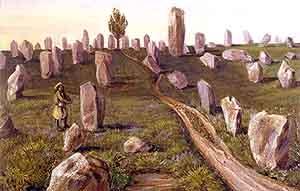- Home
- Megalithism in Morbihan
- Carnac
- From Le Menec to Toul-Chignan
The Menec "group of standing stones" is the westernmost of the largest Carnac megalithic monuments. According to latest counts, it consists of 1,050 menhirs. It stretches over 950m in length, lying south-west to north-east.
The monument starts in the south-west with an oval enclosure (70 x 90m). Some of its 71 remaining blocks can be found between the buildings of the village of Le Menec. The village was probably built during the Middle Ages, the megalithic monument having been used as a line of defense.
A total of eleven lines spread over a width of 100m lead away from this enclosure. Seven of them start on the northern side, while the other four are set a little further north. This layout is maintained over almost 400m, in spite of a few missing stones, especially in the southernmost line.
At this point, the southernmost line merges with its neighbour. From there on, it slants northwards and disappears. The set of lines then curves slightly northwards, its width decreases to less than 70m, the blocks become smaller and the layout becomes blurred. After having run for 700m, the lines come to an abrupt end when they meet what used to be a cultivated field (where stones were visible in the past).
New stones emerge just as abruptly on the eastern side of the local D.119 road beyond the Croix-Audran crossroads. This is wetland, and water is retained by the modern road running alongside it. Ten lines then carry on over a width of 70m, the blocks growing larger. After about a hundred metres, average height exceeds 2m and the set comes to another abrupt end when it meets a transversal line of nearly contiguous stones. It is commonly believed that these stones are the remains of another oval enclosure, almost entirely destroyed.
View of the western part of the Menec alignments taken from above the enclosure during early conservation work.
Scale model of the Menec monument around the village of Le Menec (left) and close to Toul-Chignan, to the north-east of the Croix-Audran crossroads (right).
Some special features of the Menec group should be highlighted.
- About one hundred metres away from the western enclosure, in the northern part of the monument, a menhir stands out because of its slender shape and its height (over 3m); it is known as the "Menec Giant". It is assumed that it was a pre-existing menhir integrated into the present monument.
- An isolated menhir stands a short distance away as the "last man in line" outside the limits of the monument.
- In the centre of the alignments, the southern line crosses its neighbouring lines in the manner of "railway points", and could be the remains of an earlier stage of site development.
- Two of the southernmost lines, consisting of adjacent blocks, run into a breach in the enclosure. It could be a via sacra leading inside the sanctuary.
Water-colour by P. Mérimée (1835) emphasizing the incongruity of the "Menec Giant" compared to the smaller surrounding blocks.


